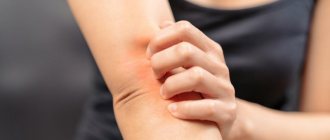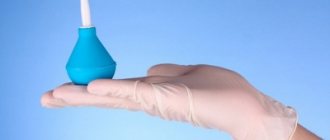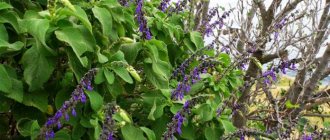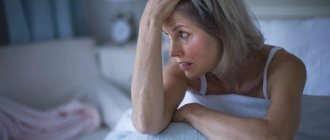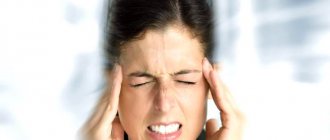I noticed a clear decrease in hot flashes, but the doctor dissuaded me! What's the result?
I give this wonderful herb the highest rating and recommend it, because when I took Sage it was much easier for me to cope with my problem.
Now about the problem itself. So I had to deal with wild hot flashes at night in the first year of menopause. And what started at night, I can’t compare with anything. I’ll try to compare this with the effect of an antipyretic drug multiplied by 16! I woke up not only wet from sweat, but I had the feeling that the roof of my house was leaking and the rain had flooded me with water. There was a real puddle on the bend of the elbow!
This condition began at the end of summer and, with short breaks, continued throughout the fall and winter. The doctor said indifferently, wait a year, then it won’t be so critical! And on one of the women's forums I read about the ability of sage to reduce hot flashes. Of course, I immediately went to the pharmacy. By the way, when taking it, it was recommended to brew it in a completely different way than on the packet of herbs.
At first I noticed a sugar-lowering effect (sage is actually used in the early and uncomplicated stages of diabetes), I thought this was great, but after a week my nightmares decreased very much, I no longer woke up in such a wildly wet state! And some nights there were no night sweats at all. Then, apparently, the body got used to it, there were hot flashes, but they were no longer so bright and nightmarish.
And what was my disappointment when, at a doctor’s appointment, I let slip that I was taking sage and that it was helping me, but the doctor convinced me that it was better to endure terrible hot flashes than to face the consequences of taking sage. Under the influence of sage, the cells of the uterine body degenerate into cysts and other neoplasms, and after 40 this happens at cosmic speed. This is me briefly conveying the doctor’s words; she told me so many terrible things that I won’t repeat them exactly, so please excuse me! Just like that! This may not always happen, but I don’t want to take risks! Sage is also contraindicated in cases of reduced thyroid function.
It’s a shame, because sage obviously made me feel better.
Sage: Natural remedy for menopause and hot flashes
✅Sage has a healing effect on the body as a whole and helps to endure the symptoms of menopause more easily. Using products based on this plant, you will certainly achieve the desired effect.
With age, the body begins to rebuild, as a result of which it loses some of its functions. Thus, closer to 50, every woman experiences menopause, which is accompanied by such unpleasant symptoms as increased sweating and hot flashes. You can make your well-being easier with the help of some medications, but herbal remedies also have a good effect, one of which is sage.
Composition and beneficial properties
Salvia has been known since ancient times as an indispensable herb for women. Its rich vitamin composition allows you to get rid of many diseases and compensate for the lack of microelements. The composition of sage leaves includes the following vitamins and microelements:
- Vitamin A,
- Vitamin C,
- Vitamin B,
- Potassium,
- Calcium,
- Manganese,
- Iron,
- Zinc,
- Copper.
In addition, Salvia contains a complex of essential oils, which give the herb a pleasant aroma. These oils also contain a lot of useful components that have a beneficial effect on the body and help fight many diseases during menopause in women. Among the most famous healing properties of sage are:
- Treatment of diseases of the upper respiratory tract.
- Used for the treatment of gastrointestinal diseases.
- Used to treat oral diseases.
- Resists heavy sweating.
- Used in the treatment of inflammatory diseases.
- Improves the appearance of nails, hair and skin, etc.
Sage for women's health
Sage is a herbaceous plant that is grown in Greece, Crimea, Russia, the Czech Republic and other countries. Its leaves are rich in essential oils, so they are often used to prepare various medicines.
Italy is considered the birthplace of sage. According to legends, it has been used to treat various pathologies since the time of Hippocrates, who called it a “sacred” herb.
Salvia officinalis has anti-inflammatory, hemostatic, antibacterial effects, and also helps to increase immunity and accelerate wound healing.
The plant is used for the following conditions:
- burns, frostbite;
- diseases of the digestive canal;
- viral diseases;
- atherosclerosis;
- bronchial asthma;
- diseases of the genitourinary system (cystitis, pyelonephritis, inflammatory processes of the genital organs);
- diseases of the nervous system;
- stomatitis;
- headache;
- inflammatory processes of the respiratory system (pharyngitis);
- menopause
Medicinal properties of sage
Sage is a perennial subshrub that grows up to 70 cm. Its flowers and leaves contain large quantities of essential oils, flavonoids, tannins, alkaloids and vitamins, thanks to which it has the following properties:
- anti-inflammatory;
- pain reliever;
- hemostatic;
- disinfectant;
- wound healing;
- reduces sweating;
- astringent;
- thermoregulating.
All of the above properties make it possible to use sage to combat infectious diseases, cystitis, diseases of the blood and blood vessels, and the gastrointestinal tract. The extract of this plant is used to disinfect and accelerate the healing of frostbite, wounds and burns.
The benefits of sage for menopause and hot flashes
During the period of decline of reproductive function, changes occur in the body, as a result of which hormonal levels change. As a result, women complain of frequent hot flashes (their number per day can reach 30 or more).
Some women are treated in a hospital, as their condition worsens significantly, and only one in five feels virtually no discomfort.
Treatment is aimed at eliminating estrogen deficiency, so patients are prescribed hormonal drugs. However, the same result can be achieved by using sage-based products. This plant is most effective in correcting hormonal levels during menopause.
Using sage-based medicines for menopause, it is possible to achieve the following positive effects:
- Normalization of hormone levels.
- Eliminate headaches. This symptom is caused by vasospasm. The plant contains substances such as carotenes and saponins, which improve blood flow.
- Decreased production of sweat gland secretions.
As a rule, to achieve the effect, it is enough to take sage once a day.
- Relief from attacks of dizziness. During menopause, a woman's body loses a large amount of nutrients. Medicines based on sage help restore their quantity and eliminate unpleasant symptoms.
- Eliminate irritability. The vitamins that make up sage help normalize the psycho-emotional state, prevent the development of depression, and fight stress.
Thus, this plant can significantly reduce the intensity of symptoms during menopause. In order to completely get rid of them, it is necessary to combine the use of sage with traditional methods of treatment .
Contraindications
You should avoid using sage during menopause if you have the following conditions:
- epilepsy;
- diabetes;
- hypertonic disease;
- acute nephritis;
- endometriosis;
- decreased thyroid function;
- breast tumors, as well as surgery to remove them;
- dryness of mucous membranes (oral cavity, vagina and others);
Important! Sage is contraindicated during pregnancy and breastfeeding.
Cooking methods
To cope with the unpleasant symptoms of menopause, you can take sage in the form of:
Each of these products must be properly prepared to achieve the desired result.
Drinking sage tea eliminates hot flashes and helps reduce sweating.
To prepare, you need to take 1 tablespoon of dry raw materials, pour 400 ml of boiling water and let it brew for a while. The finished product is taken three times a day, 1 glass.
In addition, sage can be combined with other medicinal plants.
If headaches are pronounced during menopause, then brew tea as follows: combine 1 part of valerian, horsetail and three times as much sage. Pour 1 tablespoon of the resulting mixture into 200 ml of boiling water and leave for about 5 minutes, then strain. Divide the resulting volume into 2 doses and drink per day. It is not recommended to drink this tea before bed.
The duration of tea treatment is no more than 15 days, after which you need to take a break of 1–2 weeks.
Infusion
To prepare a healing infusion, you need to pour 1 tablespoon of dried sage leaves with 200 ml of boiling water, let the product brew for 1 hour, then strain the liquid. It is recommended to drink the resulting volume within 24 hours. Take 1 dessert spoon. The course of treatment is 10 days, followed by a break of 2 weeks.
Alcohol tincture
To prepare the tincture , place 1.5 tablespoons of dry sage in a glass container and pour 250 ml of vodka or alcohol into it. The resulting mixture must be infused in a bright place for 30 days. You need to use 1 tablespoon of the product, diluting it with water, several times a week.
Methods of application
Sage is used not only in folk medicine. Having studied its beneficial properties, pharmaceutical companies have created medications based on it. You can also buy dried sage herb in pharmacies, which was grown in an environmentally friendly environment. You can grow or collect grass yourself - the plant is quite unpretentious and grows everywhere.
Important! It is prohibited to collect medicinal plants near highways, hazardous industries, or in contaminated areas.
Methods of using the medicine depend on its form. A gynecologist will help you choose the optimal form of the drug, who will tell you how to take the medicine correctly and how it affects the body.
Does sage help with menopause and hot flashes and how can women take this herb to its advantage?
The onset of menopause brings with it irritability, hot flashes, headaches, and depression. Not all women during menopause take drugs with synthetic hormones. This is due to their side effects, contraindications, and individual intolerance. Herbal remedies can help reduce symptoms and reduce the frequency of their occurrence. Sage during menopause is indicated in case of contraindications to hormone replacement therapy. The herbal medicine reduces the severity and frequency of symptoms during menopause.
General description of sage
The medicinal plant sage grows in the form of a subshrub. Found in the wild, it is cultivated on an industrial scale and grown for medicinal purposes. The flowering tops of sage bushes are used for herbal medicine. Sage raw materials are dried and essential oils, tablets and tinctures are made from it. Natural herbal preparations are recommended if there are contraindications to medications. Herbal medicine is gentler and less likely to cause side effects.
Sage contains:
- flavonoids;
- linoleic acid glycerides;
- tannins;
- caffeic acid and its derivatives;
- fixed oils;
- ursolic acid;
- alkaloids;
- camphor.
Thanks to its composition, sage is endowed with the following properties:
- antiseptic;
- astringents;
- diuretics;
- fungistatic;
- virusostatic;
- reduces sweating;
- strengthens the central nervous system;
- antispasmodic;
- anti-inflammatory;
- general strengthening;
- increases estrogen levels;
- reduces prolactin levels;
- improves skin elasticity;
- calms down.
Despite its positive qualities, the herb has side effects from use. If you do not exceed the dosage and take breaks, the risk of their development is reduced.
Due to the content of phytoestrogens, sage herb is used for menopause, ovulation disorders, and to stop lactation.
Contraindications for use:
- lactation;
- allergy;
- acute inflammatory diseases in the kidneys;
- pregnancy.
- tea;
- pills;
- essential oils;
- lozenges;
- syrup;
- herbal mixtures with other herbs.
Essential oils are used in aroma lamps, pendants or added to bath water. To aromatize the air, use 2-3 drops, for water procedures - 8-10. This therapy relaxes, relieves stress, and reduces headaches. Before using any dosage form, you should consult your doctor.
Sage relieves symptoms during menopause:
- dizziness;
- insomnia;
- tides;
- irritability;
- depression;
- mood swings.
If you feel worse, you should stop taking it and consult a doctor. The herbal extract is not endowed with the properties of medications and does not replace them.
For menopause and hot flashes, sage is used in the form of tea, tablets, or as an aromatherapy agent.
The herbal medicine does not cure the disease, but relieves the symptoms. Used in complex therapy of female diseases. As a stand-alone remedy it is ineffective.
Healing properties for women
Phytoestrogens relieve pain during menstruation, regulate ovulation, alleviate the symptoms of menopause, and stimulate the formation of their own hormones.
Use for conception
Sage normalizes hormonal levels, increases estrogen levels, which affects a woman’s behavior, her mood, and possibly promotes conception. Sage for pregnancy is prescribed in combination with other herbs (hogweed, red brush) in the form of tea drinks or decoctions after examination by a gynecologist and tests for hormones.
Do not take together with synthetic hormones.
hot flashes during menopause treatment without hormones forum
- Trade name of the drug: Clomiphene, clostilbegit
- Group affiliation of drugs: Antiestrogen
- Description of the active substance (INN) of drugs: Clomiphene
- Dosage form of clomiphene, clostilbegit: tablets containing 50 mg of clomiphene citrate
name of the drugs: Clomifene
Pharmachologic effect:
An anti-estrogen of a non-steroidal structure, the action of which is due to specific binding to estrogen receptors of the ovaries and pituitary gland. When the content of estrogen in the body is low, it exhibits a moderate estrogenic effect, and when the content is high, it has an antiestrogenic effect. In small doses, it enhances the secretion of gonadotropins (prolactin, FSH and LH), stimulates ovulation; in large doses inhibits the secretion of gonadotropins. It does not have gestagenic or androgenic activity.
Indications Klostilbegit
Indications for clomiphene are as follows: Infertility: anovulatory infertility (ovulation induction), dysfunctional metrorrhagia, amenorrhea (dysgonadotropic form), secondary amenorrhea, post-contraceptive amenorrhea, galactorrhea (due to a pituitary tumor), polycystic ovary syndrome (Stein-Leventhal syndrome), Chiari-Frommel syndrome , androgen deficiency, oligospermia in men, diagnosis of disorders of the gonadotropic function of the pituitary gland.
Contraindications for clostilbegit
Hypersensitivity, hepatic and/or renal failure, metrorrhagia of unknown etiology, ovarian cyst, genital neoplasms, tumor or hypofunction of the pituitary gland, endometriosis, ovarian failure due to hyperprolactinemia, pregnancy.
Side effects of clomiphene, clostilbegit:
Side effects from the nervous system: dizziness, headache, drowsiness, slower speed of mental and motor reactions, depression, increased excitability, insomnia. Side effects from the digestive system : nausea, vomiting, gastralgia, flatulence, diarrhea. Allergic reactions: rarely - rash, allergic dermatitis, vasomotor disorders. Side effects from the genitourinary system : rarely - polyuria, increased urination, pain in the lower abdomen, dysmenorrhea, menorrhagia, enlarged ovary (including cystic). Other side effects : weight gain, flushing of the face, rarely - decreased visual acuity, alopecia, pain in the mammary glands.
Alcohol may increase the side effects of Clomiphene.
Overdose of clostilbegit.
Symptoms : nausea, vomiting, flushing of the face, blurred vision. Treatment: discontinuation of the drug (symptoms of overdose go away on their own).
Method of administration and dosage of drugs:
To stimulate ovulation, clomiphene and clostilbegit are prescribed 50 mg 1 time per day before bedtime, starting on the 5th day of the menstrual cycle, for 5 days (in the absence of a cycle, at any time). If there is no effect (ovulation does not develop within 30 days), increase the dose of the drug to 150 mg/day or extend the course to 10 days. The course dose should not exceed 1 g. The development of ovulation is determined by the presence of biphasic basal temperature, an average cyclical increase in LH production, an increase in serum progesterone during the probable middle phase of luteinization or during menstrual bleeding in women with amenorrhea. If ovulation occurs but there is no pregnancy, then the same dose of clostilbegit should be repeated during the next treatment course. If menstrual bleeding does not follow after ovulation, the possibility of pregnancy should be taken into account, and this possibility must be excluded before a new course of treatment.
For men, clomiphene is prescribed 50 mg 1-2 times a day for 3-4 months (systematic monitoring of spermatogram is required).
Special instructions for the drugs clomiphene and clostilbegit:
During treatment with clomiphene, it is recommended to monitor liver function. Clostilbegit increases the likelihood of developing multiple pregnancies. The drug is effective when the level of endogenous estrogens is sufficient, less effective when the level of estrogens is low and practically ineffective when the concentration of pituitary gonadotropic hormones is low. During the treatment process, constant supervision by a gynecologist is necessary; ovarian function should be monitored, vaginal examinations should be performed, and the “pupil” phenomenon should be observed. During the treatment period, care must be taken when driving vehicles and engaging in other potentially hazardous activities that require increased concentration and speed of psychomotor reactions.
Interaction with other drugs:
Clomiphene is compatible with gonadotropin hormones.
The description of the drug is not intended to prescribe treatment without the participation of a doctor.
Clostilbegit and hope for pregnancy
Clomiphene, or Clostilbegit, is used in combination with other drugs to stimulate ovulation. The purpose of stimulation is to cause the maturation of one or more eggs. The main effect of Clomiphene is that the drug increases the level of follicle-stimulating (FSH) and luteinizing (LH) hormones. At the same time, the production of prolactin by the pituitary gland increases, and its content in the blood above normal interferes with ovulation, therefore, before and during stimulation, prolactin control (PRL) and, if necessary, the prescription of prolactin-lowering drugs are required.
Clostilbegit is prescribed from the 5th to the 9th day of the menstrual cycle, the dose depends on your hormone tests, which must be taken before stimulation. The dose for treatment must be selected by a qualified doctor and only a doctor! Stimulation is carried out under ultrasound control. The first ultrasound is usually performed a week after the start of stimulation. Next, an ultrasound is performed every two to three days until the follicles grow to the required size - about 20-25mm.
If Clostilbegit does not help, the follicle does not grow and ovulation does not occur within 3 cycles even with an increase in dosage, stimulation methods should be reconsidered and additional examination should be carried out for previously undetected pathologies. It is important to understand that Clomiphene only stimulates ovulation, but does not help implantation of the embryo, resorption of adhesions, etc. It is important to conduct a full examination before stimulating ovulation in order to exclude other causes of infertility, in particular tubal infertility and male factor. In addition, a side effect of Clostilbegit is a change in pH and thickening of the cervical (cervical) mucus, which interferes with the advancement of sperm. That is why pregnancy, when stimulated by Clostilbegit, occurs, as a rule, not directly in cycles with Clomiphene, but in the interval between courses or after several courses of taking the drug, when viscosity and pH are restored. Reviews of the drug Clomiphene or Clostilbegit fully confirm this.
For polycystic ovary syndrome, clostilbegit is one of the main drugs that help restore ovulation. However, by restoring ovulation, clomiphene may slightly increase the viscosity of cervical mucus. In most cases, this additional action is not critical, and pregnancy occurs. The additional administration of duphaston during ovulation further worsens the permeability of the cervix for sperm.
Under no circumstances start taking Clomiphene without a doctor’s prescription and do not increase the dosage on your own! Firstly, the dose of the drug determines whether it will stimulate ovulation or suppress it, and secondly, hyperstimulation threatens the formation of cysts and your possible pregnancy will be delayed indefinitely. It is also not recommended to carry out more than 6 courses of ovarian stimulation in a lifetime. The price of an unskilled approach to stimulation is your health. The effect of the drug lasts for several years, and the supply of eggs in the female body is limited and after hyperstimulation, ovarian hyperfunction occurs, which threatens ovarian depletion and early menopause. Hyperfunction of the ovaries is deliberately achieved through stimulation during the IVF process, and this is the main side effect of the long-awaited pregnancy, which persists for many years.
With the correct selection of the dosage of Clostilbegit during stimulation (IVF does not count), the consequences are minimized and, as a rule, the second and subsequent pregnancies occur without problems, and early menopause is not threatened.
They write that Clostilbegit and Clomiphene have a pronounced anti-estrogenic effect, but this is not so. Whether the effect is estrogenic or antiestrogenic depends entirely on the dosage, and if the dosage is selected correctly, the drug will not adversely affect the growth of the endometrium.
Support for the second phase of the menstrual cycle after stimulation with Clomiphene is usually carried out with Duphaston or Utrozhestan. In order to prevent the development of insufficiency of corpus luteum function after treatment with Clostilbegit, it is recommended to carry out prophylactic treatment with progesterone Duphaston or Utrozhestan after conception. Clostilbegit is used only with constant supervision by a gynecologist.
After taking the drug, you need to check and, if necessary, restore liver function, otherwise severe toxicosis and late gestosis during pregnancy may occur.
Ask your obstetrician-gynecologist your questions about stimulation with Clomiphene on the forum.
